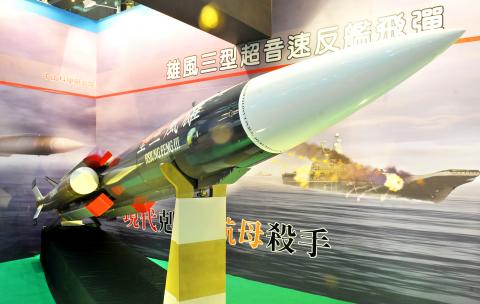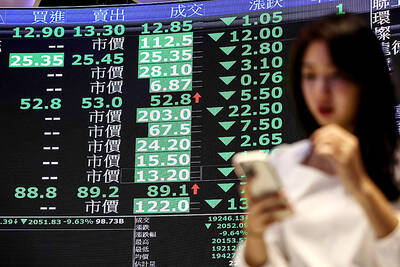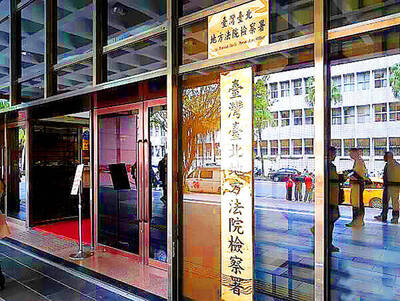In a blunt departure from tradition, the military yesterday displayed a model Hsiung Feng (“Brave Wind”) III (HF-3) anti-ship missile with, as a backdrop, a large picture of a burning aircraft carrier that bore a striking resemblance to China’s retrofitted Varyag, which embarked on its maiden voyage earlier in the day.
The booth, set at a prominent location at the Taipei Aerospace and Defense Technology Exhibition (TADTE), which opens today, was the center of attention of reporters who were given a chance to take a look around during a pre-show visit.
The HF-3, a ramjet-powered supersonic anti-ship missile, can be launched from land and surface platforms, such as Taiwan’s Perry-class frigates. The 130km-range, single-warhead missile has been in development at the Chung-Shan Institute of Science and Technology (CSIST, 中山科學研究院) since 1995. It entered production in about 2007 and is believed to have entered service the following year.

Photo: CNA
The CSIST is administered by the Ministry of National Defense’s Armaments Bureau.
Asked to confirm how many missiles were currently in production or had been deployed, Chiang Wu-ing, deputy director of the Hsiung Feng program at CSIST, would not provide figures.
While the HF-3 had been on display at previous shows, this was the first time it was shown in a context that prominently identified its intended target. Although no flag or ensign could be seen on the computer-generated rendition of the aircraft carrier and accompanying fleet, the “ski jump” ramp and general outlook were oddly similar to the Varyag China acquired from Ukraine in 1998.
Next to the burning carrier were the Chinese characters for “carrier killer,” also the first time the HF-3 had been described as such. It is doubtful, however, that the missile’s 120kg payload would be sufficient to sink an aircraft carrier.
Approached by reporters for comment on the symbolism and timing of the display, a CSIST spokesperson would not directly confirm that the vessel depicted was the Varyag.
For his part, Chiang said that when the HF-3 entered development and even after it had entered production, the Taiwanese military and CSIST could not have known that China would acquire and refurbish the Soviet-era Varyag or embark on a program to develop its own carriers, expected to enter service in about 2020.
Initial reports had said the 60,000 tonne Kuznetsov-class carrier would embark on its maiden voyage on July 1 to coincide with the 90th anniversary of the founding of the Chinese Communist Party, but unexpected developments forced a delay until this month.

Intelligence agents have recorded 510,000 instances of “controversial information” being spread online by the Chinese Communist Party (CCP) so far this year, the National Security Bureau (NSB) said in a report yesterday, as it warned of artificial intelligence (AI) being employed to generate destabilizing misinformation. The bureau submitted a written report to the Legislative Yuan in preparation for National Security Bureau Director-General Tsai Ming-yen’s (蔡明彥) appearance before the Foreign Affairs and National Defense Committee today. The CCP has been using cognitive warfare to divide Taiwanese society by commenting on controversial issues such as Taiwan Semiconductor Manufacturing Co’s (TSMC, 台積電) investments in the

HELPING HAND: The steering committee of the National Stabilization Fund is expected to hold a meeting to discuss how and when to utilize the fund to help buffer the sell-off The TAIEX plunged 2,065.87 points, or 9.7 percent, to close at 19,232.35 yesterday, the highest single-day percentage loss on record, as investors braced for US President Donald Trump’s tariffs after an extended holiday weekend. Amid the pessimistic atmosphere, 945 listed companies led by large-cap stocks — including Taiwan Semiconductor Manufacturing Co (TSMC, 台積電), Hon Hai Precision Industry Co (鴻海精密) and Largan Precision Co (大立光) — fell by the daily maximum of 10 percent at the close, Taiwan Stock Exchange data showed. The number of listed companies ending limit-down set a new record, the exchange said. The TAIEX plunged by daily maxiumu in just

INVESTIGATION: The case is the latest instance of a DPP figure being implicated in an espionage network accused of allegedly leaking information to Chinese intelligence Democratic Progressive Party (DPP) member Ho Jen-chieh (何仁傑) was detained and held incommunicado yesterday on suspicion of spying for China during his tenure as assistant to then-minister of foreign affairs Joseph Wu (吳釗燮). The Taipei District Prosecutors’ Office said Ho was implicated during its investigation into alleged spying activities by former Presidential Office consultant Wu Shang-yu (吳尚雨). Prosecutors said there is reason to believe Ho breached the National Security Act (國家安全法) by leaking classified Ministry of Foreign Affairs information to Chinese intelligence. Following interrogation, prosecutors petitioned the Taipei District Court to detain Ho, citing concerns over potential collusion or tampering of evidence. The

‘COMPREHENSIVE PLAN’: Lin Chia-lung said that the government was ready to talk about a variety of issues, including investment in and purchases from the US The National Stabilization Fund (NSF) yesterday announced that it would step in to staunch stock market losses for the ninth time in the nation’s history. An NSF board meeting, originally scheduled for Monday next week, was moved to yesterday after stocks plummeted in the wake of US President Donald Trump’s announcement of 32 percent tariffs on Taiwan on Wednesday last week. Board members voted to support the stock market with the NT$500 billion (US$15.15 billion) fund, with injections of funds to begin as soon as today. The NSF in 2000 injected NT$120 billion to stabilize stocks, the most ever. The lowest amount it